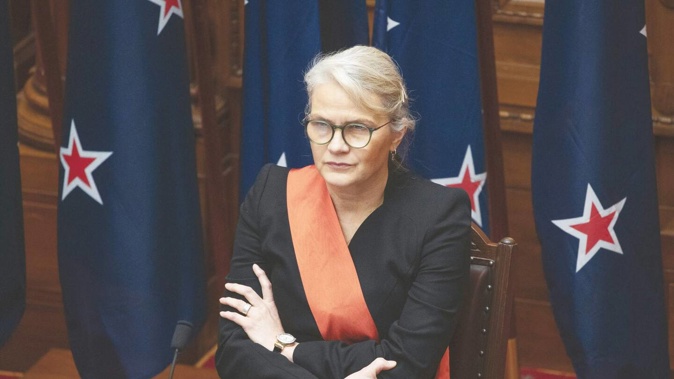

The justice system is under “considerable stress” with too few judges and, in some areas, not enough courtrooms.
Chief Justice Dame Helen Winkelmann today released her annual report, which detailed high workloads causing delays in the courts, increasing security concerns, and the “difficult and distressing” nature of cases being heard.
She also said that constraints on the legal aid system were causing some lawyers to pull out of it, leading to “serious concern” among judges.
“Overall, our justice system is under considerable stress.”
“Court resourcing, and in particular judge numbers, has not kept up with population growth and increasing case volumes,” she said in the report.
“Nor has it taken account of the increased complexity of proceedings.
“These factors have led to increased and unsustainable caseloads for many judges.”
Number of judges capped
The number of judges who can be appointed is limited by legislation.
For example, the statutory cap for judges in the senior courts – the High Court, Court of Appeal and Supreme Court – is 55 plus the Chief Justice.
This limit has remained the same since 2004 despite an increase in the workload of the courts and the complexity of the cases being heard.
“As a consequence, the High Court and the Court of Appeal have insufficient judges to manage the workload,” the report said.
“This is a significant contributor to delays in these courts.”

Prime Minister Christopher Luxon sitting in front of Chief Justice Dame Helen Winkelmann and senior court judges during the State Opening of Parliament in 2023. Photo / Mark Mitchell
To help manage this, acting judges are being appointed from the ranks of those between the mandatory retirement age of judges, which is 70, and the maximum age they can sit on the bench, which is 75.
“The challenge is even greater in the District Court, where acting judges currently make up 16% of the effective bench.”
The report said the statutory cap on the number of judges needed to be adjusted.
High Court trials running longer
The High Court, which hears the most serious criminal cases, including murder, manslaughter, attempted murder, and serious sexual, drug and violent offending, is now unable to provide “timely” hearings, the report said.
Criminal trials were also becoming longer and more complex.
In the last year, the average number of days per trial rose to a “historically-high” level of 17.2 days, compared with 14.4 days per trial only four years ago.
Reasons include the rise in the number of multiple-defendant trials, an increase in the evidence that must then be tested in court, particularly evidence collected from electronic devices, and an increased number of charges for each defendant.
There had also been an increase in the number of trials for the most serious “Category 4” offences – murder, manslaughter, and attempted murder – which now account for 76% of all new criminal trials in the High Court.
In 2021, these made up 56% of new criminal trials.
The overall number of criminal trials in hand before the High Court at a particular time has decreased over the past four years – from 162 to 155 – but only because the High Court is not taking as many serious cases from the district courts, increasing pressure on those courts.
Increased security concerns
The report said judges and the Ministry of Justice are concerned about a rise in violent incidents and disruption in courthouses over the last year.
In March, regular security briefings were extended beyond the judiciary and staff to all people who regularly attend court for work, including the police and Department of Corrections staff, lawyers and journalists.
The ministry is also continuing a dock upgrade programme, creating more separation between defendants in the dock and court participants.
Legal aid underfunded
The report said long-term underfunding of legal aid – funding for defendants who can’t afford a lawyer - had resulted in a reducing pool of legal professionals who are prepared to take on work at legal aid rates.
“This affects all court work, but has particularly affected the criminal defence bar, where there is now a grave shortage of senior practitioners available for more complex and serious cases,” the report said.
Those who remained now had “unacceptably high” workloads.
Justice Winkelmann said the legal aid system did not adequately serve the people needing representation, or the lawyers undertaking the work.
“For those who require legal representation, the eligibility thresholds are set unacceptably low, meaning that many people who cannot afford to pay for legal advice are still not eligible for legal aid.”
For lawyers willing to do the work, the pay rates were inadequate, and the administrative burden cumbersome.
The Ministry of Justice is currently reviewing the legal aid system.
Work-related stress for judges
The report said that the high workloads, exposure to distressing evidence, case management pressures, and the rising security concerns were causing work-related stress for judges.
Judges were able, and encouraged, to get professional support as a routine part of their jobs.
Courtrooms lacking
A lack of courtrooms in places such as Whangārei and Rotorua is affecting the High Court’s ability to schedule trials and is adding to significant delays.
“For example, there is only one courtroom available to the High Court at Whangārei to deal with all civil and criminal work in Northland,” the report said.
“This constraint is delaying the conduct of criminal jury trials in the Whangārei High Court, with the result that hearing dates are being scheduled well in excess of the 12-month timeframe that is generally required to bring a case in the High Court to trial.”
The report said Justice Winkelmann had raised the issue with the Government.
Ric Stevens spent many years working for the former New Zealand Press Association news agency, including as a political reporter at Parliament, before holding senior positions at various daily newspapers. He joined NZME’s Open Justice team in 2022 and is based in Hawke’s Bay.

Take your Radio, Podcasts and Music with you









